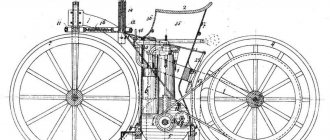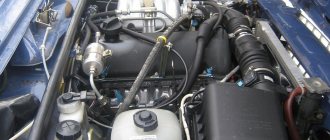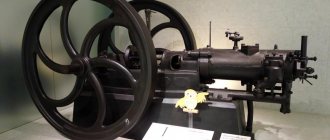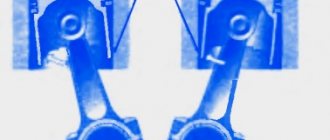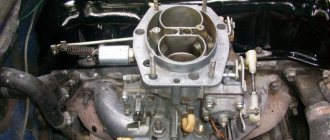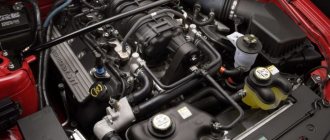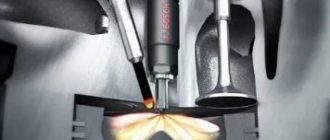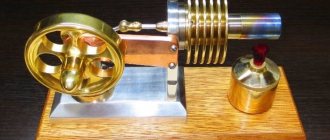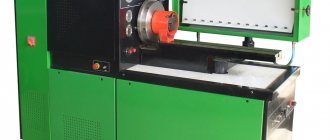Undivided combustion chamber
Direct injection engines (Figure 1) are more efficient and run more economically than split-cam engines, which is why they are used in all trucks and most new passenger cars.
Fig. 11. Multi-string atomizer2. ' / shaped recess in the piston3. Pin glow plug
With direct injection, the fuel immediately enters the combustion chamber 1 with a w-shaped recess 2 located in the piston, so atomization, heating, evaporation and mixing of fuel with air must quickly follow each other. At the same time, high demands are placed on the supply of not only fuel, but also air. During the intake and compression strokes, an air vortex occurs in the cylinder due to the special design of the intake duct in the cylinder head. The shape of the combustion chamber also promotes vortex movement of air at the end of the compression stroke (i.e. at the beginning of injection). Of the various types of recesses in the piston that form the combustion chamber, which were used at different times in the creation of diesel engines, the c-shaped recess in the piston is currently widely used. The fuel must be introduced into the combustion chamber in such a way that, evenly distributed throughout the volume of the chamber, it can quickly mix with air. To do this, unlike a diesel engine with divided combustion chambers, where a pin-type injector is used, direct fuel injection uses a multi-jet injector 1. The distribution of its fuel jets must be optimized and coordinated with the parameters of the combustion chamber. The injection pressure during direct fuel supply is very high (up to 2000 bar). In practice, with direct injection, two methods are used to intensify mixture formation: • through targeted air movement; • through fuel injection - without using air movement.
In the second case, there is no energy consumption for swirling air at the inlet, which reduces gas exchange losses and improves cylinder filling. The use of this method, however, places increased demands on the location and number of holes in the injector nozzle, as well as on the fineness of fuel atomization, which is determined by the diameter of the nozzle hole. In addition, to achieve short injection times and good fuel atomization, a very high injection pressure is required.
Diesel combustion chambers
Author: Julius Mackerle Source: "Modern economical car" [1]20737 0
For diesel engines, the requirements for the shape of the combustion chamber are determined by the mixture formation process. They take very little time to create a working mixture, since almost immediately after the start of fuel injection, combustion begins, and the remainder of the fuel is supplied to the burning environment. Each drop of fuel must come into contact with air as quickly as possible so that heat is released at the beginning of the expansion stroke.
To meet these requirements, it is necessary to create intense directed air movement, but this process must be organized so that the amount of air necessary for combustion is mixed with the injected fuel. In principle, there are two possibilities for this purpose: directing either air to fuel or fuel to air. Automotive diesel engines use both methods.
In the first of them, fuel is injected directly into the cylinder by several jets (torches), which are blown by a rotating air stream. The flow rate must ensure that the air travels from one jet to another during combustion [2].
The number of jets, however, is limited, and therefore the required amount of fuel must be injected at a certain speed to ensure good atomization. If the fuel is well atomized, it warms up quickly after being injected into the hot air, and the time before it ignites (the so-called ignition delay) is reduced. A short ignition delay time is necessary so that the amount of fuel supplied to the combustion chamber during this period is not so large that after ignition it causes a sharp increase in pressure and greater rigidity of the engine. Regulation of the combustion process can be ensured by the law of fuel supply into an already ignited environment.
If the speed, time and amount of fuel supplied are determined, then the diameter of the power holes of the injector nozzle can be calculated, given their number. To eliminate the danger of coking and ensure manufacturability of injector nozzles, the minimum hole diameter is limited to 0.25-0.3 mm. Therefore, their number in automobile diesel engines does not exceed 4-5. In accordance with this, the intensity of air rotation should be set. Rotational movement of air in the cylinder can be created using a tangential or helical intake duct. Just like with gasoline engines, additional charge turbulence in a diesel engine can be created at the end of the compression stroke by displacing air from the space between the piston bottom and the cylinder head.
Forming a mixture using the second method - supplying fuel to air - is difficult if a large number of injectors cannot be used. In diesel engines with separated combustion chambers (pre-chamber and swirl chamber), injection is carried out in such a way that all the fuel is supplied to a small-volume auxiliary chamber containing only part of the air entering the cylinder. When the fuel ignites in this chamber, the pressure increases and displaces the unburned fuel into the volume of the main combustion chamber above the piston, where combustion is completed.
Thus, according to the method of mixture formation, a distinction is made between diesel engines with direct fuel injection into the cylinder and diesel engines with a divided combustion chamber. With direct injection, the combustion chamber is formed in the piston, which has a higher temperature than the cooled cylinder head. This reduces the heat loss of hot gases into the walls of the combustion chamber. The combustion chamber must be compact so that heat losses during air compression are also not large and, therefore, to achieve the temperature necessary for ignition of the fuel, a too high compression ratio is not required. The compression ratio of a diesel engine is limited from above by the load on the crank mechanism and friction losses, and from below by the conditions for ensuring the so-called cold start. With direct injection, the compression ratio ε ranges from 15 to 18. During a cold start, diesel engines of this type do not require additional measures to ensure fuel ignition.
In a diesel engine with a divided combustion chamber, air enters the auxiliary chamber through the connecting channel at high speed during the compression stroke and is significantly cooled at the same time. Therefore, to ensure the required temperature at the time of ignition, a higher compression ratio is required - from 20 to 24, but despite this, when the engine is cold started, the air in the auxiliary chamber must be preheated using a special glow plug, which is turned off after starting the engine.
The surface area of the main and auxiliary combustion chambers is very large, and the speed of air movement near their walls also reaches high values. This means increased heat transfer into the walls, i.e., increased heat losses. In this regard, diesel engines with a separate combustion chamber have higher specific fuel consumption than diesel engines with direct injection.
So, diesel engines with direct fuel injection are more economical. Their disadvantage is significant noise during combustion, but in the latest designs this disadvantage has been practically eliminated. The main cause of noise is the high rate of pressure build-up in the initial combustion phase. To eliminate this phenomenon, it is necessary to reduce the ignition delay period and control the further course of the combustion process through the law of fuel supply.
Good results in reducing operating harshness have been achieved in diesel engines using a spherical combustion chamber located in the piston.
The nozzle in these diesel engines has only two holes, through one of which the bulk of the fuel is injected onto the wall of the combustion chamber, and through the other, a smaller pilot portion is directed to the middle of the chamber, where the air has the highest temperature. The air in the chamber is given intense rotation. The fuel located on the chamber wall is relatively cold and therefore ignition of its entire mass does not occur immediately. Fuel vapors gradually enter the air flow from the walls of the chamber, mix with it, and the resulting air-fuel mixture ignites. This ensures smooth and fairly economical operation of the engine, which is why several variants of this working process that are similar in concept have emerged.
In particular, in a cylindrical combustion chamber (CC), one jet is injected parallel to the chamber axis into the space near the wall. The results obtained with this method can also be assessed positively. It should be noted that with such mixture formation, much depends on the temperature of the walls of the combustion chamber.
When the combustion process is delayed, the heat released during the expansion stroke is not fully used (see Fig. 3 in the article “The influence of the compression ratio on the indicated engine efficiency”), which increases the specific fuel consumption, i.e., the advantages of direct injection fuel is actually lost. In the most widely used toroidal combustion chambers, fuel is injected along the radius of the chamber onto its wall in several symmetrical jets located at a large angle to the vertical axis. During combustion, part of the fuel reacts first, mixed with air right at the wall. The gases produced during combustion have a high temperature and low density. When the charge rotates strongly, cold air from the central part of the chamber enters the chamber walls due to centrifugal force, pushing light combustion products to the center. Directly near the walls, air mixes with fuel. In a laboratory (England) this process was recorded on film.
In diesel engines with divided combustion chambers, the auxiliary chamber is quite simple to create even with small cylinder diameters. This is quite important when converting a gasoline engine to diesel. This problem was successfully solved under the leadership of P. Hofbauer on the engine of a Volkswagen Golf car (Fig. 1).
Specific fuel consumption at a rotation speed n = 2500 min-1 of diesel and gasoline engines of a Volkswagen Golf car is shown in Fig. 2.
At an average effective pressure pe = 0.2 MPa, the specific fuel consumption of a diesel engine is 25% lower. As the load increases, the difference in fuel efficiency between a gasoline engine and a diesel engine decreases, and when operating at full load it is zero. Reducing specific fuel consumption at partial load is very important, since for passenger cars these are the most typical modes when driving in urban conditions.
| Rice. 3 |
| The influence of the placement of a glow plug in a Volkswagen diesel engine on its average effective pressure pe, specific fuel consumption ge and exhaust gas opacity K. |
Design options for a Volkswagen diesel engine, differing in the placement of the injector and glow plug, are shown in Fig. 1. Changing the location of the glow plug brought a decrease in specific fuel consumption and a decrease in exhaust gas smoke, which is reflected in the graphs shown in Fig. 3, a. The influence of the load, i.e., the average effective pressure pe on the same indicators when the engine operates at a constant speed of 3000 min-1, is shown in Fig. 3, b. The improvement is clearly visible in all engine operating modes. Option B (see Fig. 1) differs in the location of the glow plug relative to the direction of air rotation in the vortex chamber. This design, however, is quite complex when implemented in production.
The energy crisis [3] prompted many designers of automobile gasoline engines to convert them to diesel engines in order to increase the indicator efficiency. Designer and researcher from Germany L. Elsbett achieved fuel savings of up to 20% when converting gasoline engines. Its ELKO diesel engines use direct fuel injection with a single-nozzle nozzle into a spherical combustion chamber located at the bottom of the piston. The jet axis divides the chamber radius in half at the point of intersection with it. The organization of the work process uses the effect of moving hot low-density combustion products to the center of an air charge rotating in the combustion chamber. As a result, good mixing of the burning mixture with air occurs, and since combustion occurs mainly in the center of the chamber, heat losses to its walls are relatively small.
The piston consists of two parts, the upper one with the combustion chamber and piston rings located in it being made of steel. Steel has great thermal strength and worse thermal conductivity than aluminum, and therefore the surface of the combustion chamber has a higher temperature, which, in turn, reduces heat transfer from hot gases to the chamber walls.
This solution also prevents increased wear of the piston grooves, which is typical for aluminum diesel pistons.
The piston skirt, which serves as a guide, is made of aluminum alloy and is connected to the upper part through a piston pin. This design of the piston has the properties of a crosshead, i.e. it reduces the lateral forces acting on the cylinder wall that arise during the movement of the connecting rod, and creates the prerequisites for elimination, which is one of the sources of noise during the operation of the tilting torque engine, which acts on the upper part of the piston.
To reduce the specific pressure on the piston pin, the upper head of the connecting rod and the bosses of the piston crown have a wedge-shaped cross-section along the axis of the pin. Due to this, the area of the upper part of the piston crown boss is larger than its lower part. Likewise, the lower part of the connecting rod bushing also has a larger area than the upper part. The edges of the piston pin absorb only minor forces from the piston skirt.
Water channels in the cylinder head of the ELKO diesel engine are excluded. Heat is removed only from the most important places, such as inter-valve bridges and injector holes using oil circulating through specially drilled channels with a diameter of 6-8 mm. In order to reduce heat dissipation, the cylinders are cooled so that the temperature of their upper zone does not exceed the temperature necessary to ensure lubrication.
With such a reduction in heat removal into the cooling system, a larger amount of heat is removed, but with the exhaust gases, which naturally leads to the use of a turbine to use this heat. Specific fuel consumption of ELKO diesel engines is shown in Fig. 4, which presents the multi-parameter characteristics of a five-cylinder diesel engine with a displacement of 2300 cm3 and a power of 80 kW (Fig. 4, a) and a six-cylinder diesel engine with a displacement of 13,300 cm3 (Fig. 4, b) [4]. Both diesel engines have gas turbine supercharging without intermediate cooling of the charge air.
| Rice. 4 |
| Characteristics of ELKO diesel engines: a - five-cylinder engine with a displacement of 2300 cm3; b - six-cylinder engine with a displacement of 13300 cm3. |
Reducing heat transfer to the cooling system allows the use of a smaller radiator and, accordingly, a lower power fan. If we take into account the need to heat the car during the cold period, for which the heat removed from the engine is quite sufficient, then a radiator for cooling the engine during this period may not be required at all.
| Rice. 5 |
| Design of the piston and cylinder head of the ELKO diesel engine. |
When comparing specific fuel consumption, it is necessary to take into account the influence of a number of factors. Thus, the larger the cylinder diameter, the more favorable conditions are available for achieving low specific fuel consumption. The ratio of the cylinder diameter to the piston stroke is also important. L. Elsbett calls his diesel engine “thermal insulated,” which is a definite step forward in the direction of creating an adiabatic engine, which will be discussed in the following chapters of the book. Some design features of the ELKO diesel engine are shown in Fig. 5.
Direct injection diesel engines, compared to diesel engines with divided combustion chambers, have better conditions for reducing heat losses into the cooling system. It was already mentioned above about less intense cooling of the surface of the combustion chamber and a decrease in the speed of movement of hot gases near the walls. However, even with direct injection, different conditions for heat removal can be created. As an example in Fig. Figure 6 shows the process of improving the combustion chamber of the Tatra 111A diesel engine (Czechoslovakia).
| Rice. 6 |
| Improving the combustion chamber of the Tatra 111A diesel engine: a - original version; b - modernized version. |
The first version of this air-cooled diesel engine used a hemispherical combustion chamber. In this way, with the help of large valves, they sought to obtain good filling of the cylinder and, thanks to the large valve angle, to provide the possibility of creating cooling fins in the area of the exhaust valve seat. To obtain the required volume of the combustion chamber, the piston bottom had a dome-shaped shape, the combustion chamber lost its compactness, and its developed cooling surfaces led to large heat losses and lower temperatures at the end of compression.
By reducing the valve camber angle and using an almost parallel arrangement, we achieved an almost flat bottom of the cylinder head and a reduction in the cooling surface. The combustion chamber was placed in the piston crown and became more compact. The temperature of the walls of the combustion chamber in the piston increased, and the heat removal through them decreased. The narrow neck of the combustion chamber ensured intense air swirl during compression, which contributed to improved mixture formation and regulation of the combustion process. Thus, heat losses during combustion were reduced, cold start conditions were improved, and noise was reduced. Specific fuel consumption decreased by 15%. Comparison of the initial and modernized versions of the combustion chamber shown in Fig. 6 is an example of how combustion chamber design can reduce fuel consumption.
Last updated 03/02/2012 Published 05/26/2011
Top
Chamber - combustion - diesel engine
Efficiency of an internal combustion engine.
How much is approximately, as well as power percentage The combustion chambers of diesel engines used by land vehicles are mainly located in the piston. The inlet channel creates the necessary swirl of the air flow to improve the processes of mixture formation and combustion of a fresh charge. In the case of a transition to gas motor fuel, as a rule, there is no technological ability to change the geometry of the flow part of the intake parts, and the nature of the movement of the fresh charge in the engine cylinder can only be influenced by selecting the appropriate combustion chamber.
| Combustion chambers of diesel engines. |
The combustion chambers of diesel engines are of undivided and divided types.
The standard combustion chamber of a diesel engine, having a small volume and, accordingly, providing a high compression ratio, does not guarantee the use of natural gas as fuel, since it does not provide knock-free operation over the entire range of speed and load conditions. When changing the geometry of the combustion chamber, it is necessary to take into account that in a spark-ignition gas engine, the level of turbulization of the fresh charge in the cylinder before ignition and during the combustion process has a significant impact on environmental and economic performance.
The standard combustion chamber of a diesel engine, having a small volume and, accordingly, a high compression ratio, does not allow the use of natural gas as fuel, since it does not provide knock-free operation over the entire range of speed and load conditions. When changing the geometry of the combustion chamber, it is necessary to take into account, in addition, the fact that in a spark-ignition gas engine, the level of turbulization of the fresh charge in the cylinder before ignition and during the combustion process has a significant impact on environmental and economic performance.
The combustion chamber of diesel engines of the second type consists of a main and an additional chamber. At the end of the compression stroke, fuel is injected through a nozzle into the additional chamber, where it partially burns, after which the combustion products and unburned fuel flow into the main chamber, where the combustion process is completed. Good mixing of fuel with air and complete combustion of the resulting mixture in engines of this type are achieved due to the flow of gases at high speed through the channel connecting both parts of the combustion chamber.
The shape of the combustion chamber of a diesel engine is mainly determined by the mixture formation method used. The combustion chambers of diesel engines are divided into divided and undivided.
In the combustion chamber of a diesel engine, the mixture is heterogeneous. Thus, the nature of mixture formation, pre-flame transformations, ignition and combustion in a diesel engine determines significantly larger amounts of soot formation compared to gasoline engines.
| Indicator diagram of a diesel engine (explanations in the text. |
The air-fuel mixture in the combustion chamber of a diesel engine is never uniform in temperature, so the development of pre-flame reactions always occurs differently in its individual parts.
It is very dangerous if a significant amount of oil gets into the combustion chamber of a diesel engine. In this case, turning off the fuel supply by the pump does not stop the increase in speed, since the fuel is burning oil and it is difficult to stop the engine immediately. Therefore, it is necessary first of all to load the engine to the point of stalling, reduce the compression pressure in the cylinders and turn off the fuel supply.
In Fig. Figure 55 shows the dependence of the compression ratio in the combustion chamber of a diesel engine on the level of cetane number of the fuel used.
The injectors are designed for highly dispersed spray and uniform supply of fuel into the combustion chamber of a diesel engine.
The shape of the combustion chamber of a diesel engine is mainly determined by the mixture formation method used. The combustion chambers of diesel engines are divided into divided and undivided.
The current strength is directly proportional to the amount of soot deposited. Since the fuel combustion conditions in a laboratory installation differ from the combustion conditions in the combustion chamber of a diesel engine, there is no direct reliable relationship between the results obtained using the Torch method and in bench tests, although in some cases a correlation is observed.
Mixture formation with undivided combustion chambers
Previous | Contents | nextCar engines
The undivided combustion chamber is a single volume enclosed between the cylinder head and the piston. This volume is usually formed by a depression in the piston or sometimes in the engine head. The configuration of undivided combustion chambers is very diverse. Some of the most common types of such cameras are shown in Fig. 211.
Volumetric mixing. In volumetric mixture formation, fuel is injected directly into the combustion chamber. The uneven composition of the mixture, necessary to reduce the ignition delay, is obtained due to the uneven distribution of fuel in the torches and in the volume of the combustion chamber.
In the case of undivided combustion chambers, the main share of the mixture formation energy is the kinetic energy received by the fuel during injection. The energy of the air vortex in these chambers is less than the energy of the fuel.
Mixture formation is improved by creating tangential rotational movement of air in the combustion chamber. The rotating movement of air, as shown above, is produced by the process of filling the cylinder with fresh charge.
. The number of nozzle holes of the sprayer was different during the tests, but the total flow section did not remain constant.
The intensity of the vortex also increased by changing the direction of the inlet channel. Diagrams of the heads, inlet and outlet ports and valve placement are shown at the top of Fig. 212.
i the average effective pressure decreased sharply (curve 1).
Changing the engine speed mode affects the intensity of the rotational movement of air in the combustion chamber, since this changes the speed and, consequently, the kinetic energy of the air flow in the intake duct and valve. As the crankshaft speed increases, the intensity of the vortex in the combustion chamber increases, so at high rotation speeds the intensity of the vortex created by changing the direction of the intake port may be sufficient. In this case, additional air swirl using a screen on the intake valve will worsen engine performance.
Thus, at each engine speed mode, depending on the number of nozzle holes of the atomizer, the optimal intensity of the rotational movement of the air charge in the combustion chamber can be selected. Therefore, when developing the working process in a diesel engine, much attention is paid to the intensity of the tangential vortex.
The advantages of the combustion chambers under consideration include easier engine starting, as well as the possibility of boosting diesel engines by using supercharging.
8-10 MPa). The high rate of pressure increase is explained by the intense evaporation and mixing of fuel vapor with air during the ignition delay period and the long duration of this period. To reduce the operating severity when using such chambers, they strive to reduce the ignition delay period and reduce the amount of fuel injected during this period. Another disadvantage is the need to create high injection pressures, since the kinetic energy of the fuel jet is of great importance during mixture formation in undivided chambers. Therefore, in the case of closed nozzles, the pressure at which the needle begins to rise should be 2025 MPa, and the maximum spray pressure should be 4060 MPa. For unit injectors of the AR-20 and AR-21 types, the maximum injection pressures reach 120-140 MPa.
The energy of rotational movement of the charge created during the intake process may be insufficient when using sprayers with a small number of nozzle holes. As a result, the nozzle nozzle must have a large number of nozzle holes of small diameter, but at the same time they become clogged and coked more quickly during operation.
= 0,615.
= 0.35 0.37. Fuel jets coming from the four nozzle holes of the injector atomizer fall on the side walls of the chamber under the inlet edge of the neck.
= 0.75 -h- 0.9.
depends on the gap between the piston bottom and the cylinder head, limited by the manufacturing accuracy of the crank mechanism parts and their thermal deformations. When the distance between the cylinder head and the piston is reduced, less air remains in the gaps, which contributes to more complete use of air and a decrease in the minimum permissible coefficient a.
Along with the toroidal vortex, the tangential rotational movement of air is also preserved in these chambers. In the TsNIDI combustion chamber, intensive tangential air movement is not required.
Combustion chambers in the piston ensure high power and economic performance of diesel engines. At the same time, the above-mentioned advantages of undivided combustion chambers are preserved. In addition, the presence of additional vortex flows makes it possible to reduce the injection pressure and reduce the number of nozzle holes in the atomizer. The pressure for the start of lifting of the nozzle needle in the case of using combustion chambers in the piston is 15-17.5 MPa, the number of nozzle holes is two to five.
The harshness of the diesel engine and the maximum pressures of the cycle with combustion chambers in the piston are also reduced, which is explained by the smaller number of torches interacting with the air vortex and partial contact of fuel with the chamber walls. As a result, less fuel vapor is generated during the ignition delay and combustion proceeds more smoothly.
Note that in such combustion chambers, purely volumetric mixture formation is replaced by mixed, volumetric-film. The amount of fuel entering the wall or into the near-wall volume depends on the type of chamber and the operating mode of the diesel engine.
Volumetric mixture formation in the Deutz combustion chamber (Fig. 211, g) ensures a decrease in the rate of formation of the fuel-air mixture prepared for combustion during the ignition delay period. This is achieved by creating a zone with an over-enriched mixture in the near-wall volume of the combustion chamber.
A nozzle sprayer with two nozzle holes is located near the chamber wall.
During the injection process, the fuel jets move along the wall of the combustion chamber made in the piston, as shown in Fig. 211, g. Under the influence of rotational air movement, an annular zone with an over-enriched mixture is created. The volume of the mixture prepared for rapid combustion decreases, which reduces the rate of pressure build-up in the cylinder. At the same time, a sufficient rate of mixture formation is ensured after the start of ignition.
With this mixture formation method, the injection pressure, fuel supply speed and jet energy should be lower than when using combustion chambers shown in Fig. 211, a and b. This is explained by the fact that to obtain a re-enriched zone it is not necessary to improve the quality of atomization and the uniformity of fuel distribution in the volume of the torch. The injection energy must be sufficient to ensure the advance of the torch to the entire depth of the combustion chamber. However, there should be no significant ingress of fuel onto its bottom.
The operating efficiency of a diesel engine and its starting qualities with a Deutz combustion chamber are not inferior to engines with the volumetric and volumetric-film mixture formation methods described above.
Film method of mixture formation. During film mixture formation, they also strive to ensure that a minimum amount of fuel has time to evaporate and mix with air during the ignition delay period. The fuel torch is supplied at an acute angle to the wall of the combustion chamber so that the drops are not reflected, but spread over the surface in the form of a thin film 0.012-0.014 mm thick. The path of the torch from the nozzle hole to the wall should be minimal in order to reduce the amount of evaporated fuel during the movement of the jet in the combustion chamber. These conditions are satisfied by the camera shown in Fig. 211, z.
The direction of the air charge velocity vector during film mixture formation coincides with the movement of the fuel jet, which contributes to the spreading of the film over the surface of the chamber. At the same time, this reduces vaporization, since the relative speeds of fuel and air movement decrease.
= 2.2 n - 7.8 J/g, i.e. approximately 2 times less than for volume. At the same time, the energy of movement of the air charge during film mixture formation is more than 2 times higher than the corresponding values for cases of volumetric formation of fuel-air mixtures.
Small droplets and resulting fuel vapors move towards the center of the combustion chamber.
The heat for evaporating the fuel is mainly supplied from the piston, the temperature of which is maintained within 450610 K. Further increase in the temperature of the fuel is impractical, since when it comes into contact with a hot surface, instead of spreading over it in the form of a film, it begins to boil, and the fuel particles acquire a spherical shape and bounce off from the wall. Thermal decomposition and coking of the fuel is also possible. If the piston temperature rises above the permissible level, for example during supercharging, the piston bottom is cooled with oil. The rapid evaporation of the fuel film is facilitated by the movement of air at high speed relative to the walls of the combustion chamber. The evaporation process accelerates sharply after the start of combustion due to heat transfer from the flame to the fuel film. The evaporated fuel is carried away by the air flow and burns in a flame front spreading from the center of the chamber, from the initial source of ignition.
The combustion chamber described is widely used on MAN diesel engines (M-process).
= 218
MPa).
at full diesel load it is 0.250.4 MPa/°, and the maximum cycle pressure is 7.0-7.5 MPa.
The advantage of a combustion chamber with film mixture formation is satisfactory engine operation on various fuels, including high-octane gasoline.
The disadvantages of film mixture formation include difficulty starting a cold engine, since the bulk of the fuel hits the wall and its evaporation is difficult. At low loads and at idle, due to the low temperature of the piston wall and the lower heat transfer from the flame to the fuel film compared to medium and full load modes, the processes of mixture formation and combustion are delayed, which leads to an increase in the toxicity of exhaust gases. This disadvantage does not exist with mixture formation in the Deitz chamber, since with a decrease in the supply, the fuel is distributed more evenly and the combustion process is not delayed.
In the TsNIDI chamber (Fig. 211, d), part of the fuel (up to 3540% of the cyclic supply) also falls on the wall or into the wall layer.
In this chamber, the distances between the spray nozzles and the wall are relatively small, and the jet meets the chamber surface at a small angle, which promotes fuel spreading and film formation.
The general disadvantages of combustion chambers in the piston include the large height of the piston head, as a result of which its mass and inertial loads increase, which can be an obstacle to increasing the speed of diesel engines.
Size - Chamber - Combustion
Diesel engine power system - Design and malfunctions
The dimensions of the combustion chamber must be such that mixing and chemical reactions have time to complete before entering the engine nozzle. The required dimensions of the chamber are determined by the value t - the residence time of the fuel and its combustion products in the chamber, which is determined by the volume of combustion products at the combustion temperature T, the pressure in the engine p, the volume of the combustion chamber V, the ratio pV RT and the amount of fuel burned in 1 second . However, it must be borne in mind that the volume of fuel as it burns in the chamber increases from a very small value (the volume of the liquid body) to the value VK, and the residence time is calculated from this larger volume. As the pressure increases, the residence time in the chamber increases, so the chamber can be smaller at the same fuel consumption.
The dimensions of the combustion chamber must be such that mixing and chemical reactions have time to complete before entering the engine nozzle. The required dimensions of the chamber are determined by the value t of the residence time of the fuel and its combustion products in the chamber. The residence time is determined by the volume of combustion products at the combustion temperature Th, the pressure in the engine P, the volume of the combustion chamber V /, , the PV - RT ratio and the amount of fuel burned in 1 second.
| Temperature distribution in the flame tube of a small experimental chamber. a - with a burner with a flat register. b - with a burner with a conical register. |
As the size of the combustion chamber increases, the temperature of the flame tube increases. However, the available experimental material concerning combustion chambers measuring about one meter or more shows that the temperature of the flame tube does not reach dangerous levels.
As the size of the combustion chamber decreases, the vacuum created by the burner at the beginning of the chamber and the amount of recirculating gases decrease, and the latter, when burning cold gas with cold air, worsens the ignition conditions and increases the separation of the torch from the burner. With a very small chamber cross-section and combustion of cold gas with cold air, special ignition stabilizers are required to ensure stable combustion.
As the size of the combustion chamber decreases, the influence of the load on the completeness of combustion increases.
When calculating the dimensions of combustion chambers or when solving the inverse problem - choosing burners for chambers of given sizes - they are guided by experimental data from the operation of similar installations and intuition.
Ignition timing depends on the size of the combustion chamber, machine speed, load and must be determined experimentally. For transport engines operating at a non-belt speed, automatic ignition timing control is provided.
The rate of heat release directly affects the size of the combustion chamber, which should be as small as possible to reduce the size and weight of the engine. Thus, the task is to achieve high combustion intensity with minimal turbulence and losses from incomplete combustion. We have very little data on the effect of various fuels and their properties on flame sizes, although research into this issue is ongoing.
| Submersible burner. |
Therefore, it should come down to determining the size of the combustion chamber depending on the flow rate of the combustible mixture. An extremely important element of the calculation is determining the length of the combustion chamber as an indispensable condition for complete combustion of the fuel.
The barrels of detonation installations differ in the shape and size of the combustion chamber, the point of introduction of the combustible mixture and powder, the method and place of initiation of combustion of the combustible mixture, and the design features of the cooling system. More promising are barrel designs with a combustion chamber cross section that varies along the length.
In [2J], the effect of combustion chamber dimensions on the average combustion rate was considered for the first time. Similar results are relatively easy to obtain using the Avery method to determine the temperature increase due to the absorption of radiation energy.
If the width of the combustion zone becomes comparable to the dimensions of the combustion chamber, then, despite the flame covering the entire volume of the charge, combustion can be prolonged for a significant part of the expansion stroke, with a corresponding decrease in cycle efficiency. In addition, due to direct contact with the walls, the rate of heat transfer and death of active particles increases sharply, which can not only reduce the burning rate, but also lead to its complete cessation.
| Channel Emissivity and Wall Layer Transmittance for the Exponential Stripe Model with Overlapping Lines. |
Chamber - combustion - engine
Engine description Camry GSV40 3.5 2GR-FE
The combustion chamber of the engine is a direct-flow annular type and consists of the following main components: outer and inner casings, a fire part with 32 burners and two igniters.
The combustion chambers of engines with overhead valves have a number of advantages compared to the combustion chambers of engines with side valves and engines with a mixed valve arrangement. These chambers have a compact shape, due to which their relative surface area, and therefore the cooling losses, are smaller than in chambers with lateral and mixed valve arrangements. Due to lower resistance during suction (the absence of sharp turns of the intake flow and its relatively weak impacts on the piston bottom, smaller vortices and lower losses due to friction of the mixture against the chamber walls), the filling coefficient rv of engines with outboard valves is higher than that of engines with side valves.
The combustion chambers of engines with outboard valves allow higher compression ratios, which increases the engine's liter power and efficiency. The engines of Western European cars, running on gasoline with an octane number of 75 - 85, are characterized by lower compression ratios (6 5 - 8 5) than American engines.
The combustion chamber of the engine is a direct-flow annular type and consists of the following main components: outer and inner casings, a fire part with 32 burners and two igniters.
The combustion chambers of engines with outboard valves allow higher compression ratios, which increases the engine's liter power and efficiency.
The engine combustion chamber is externally cooled with fuel. The cooling system is designed on the two-pass principle, according to which the coolant passes through one tube and returns back through the adjacent one. There are designs that use a porous-regenerative system, which includes a porous insert located from the nozzle head to a line slightly below the critical section, and regenerative cooling tubes.
The combustion chamber of the engine is short, annular type, designed specifically to operate at high gas pressure. It operates smokelessly with high combustion efficiency, which is achieved through good mixing of fuel and air directly behind the injectors and the use of a swirler with increased air flow through the primary zone. In addition, an air flow separator is installed in front of the front chamber device, which guarantees air distribution along the outer and inner annular channels of the chamber.
The engine combustion chamber is annular, with evaporation type nozzles, smokeless. The high pressure turbine roller bearing is located at the rear of the inner housing.
The engine combustion chamber is annular, counter-flow, with pneumatic nozzles, and has a high combustion efficiency at the design point of engine operation. The chamber provides a low level of emission of pollutants, operating on a lean air-fuel mixture in the primary zone.
The engine combustion chamber is annular type, very short, with an original mixture-forming device. In this device, fuel is fed through 20 tubes into small vortex-type mixers, where it is pre-mixed with incoming air. This design ensures good mixing and complete combustion of fuel over a chamber length of less than 255 mm, with mixing occurring in an area of approximately 50 mm and combustion in the rest of the area.
The combustion chamber of the engine is a direct-flow annular type and consists of the following main components: outer and inner casings, a fire part with 32 burners and two igniters.
The combustion chamber of a ring-type engine has internal film and external convective cooling. To obtain the calculated temperature field at the chamber outlet, a highly efficient diffuser behind the compressor and a relatively large number (thirty) fuel injectors are used.
The design of the engine combustion chamber significantly affects its operation on the Diesel-Otto cycle on gas. The best results are obtained from single-chamber diesel engines, the worst are from engines with a divided combustion chamber and other heat-accumulating and vortex devices.
Cooling of the combustion chambers of engines, especially forced ones, is usually carried out using liquid cooling.
The combustion chamber compartment of a gas turbine engine includes: a combustion chamber collector; flame pipes; adapter pipes assemblies; fuel injectors; glow plugs; ignition transformers; flame indicators; flame transfer pipes; various elements of material support and laying.
Diesel engine fuel system design
The operating principle of a diesel engine makes it important to supply a strictly dosed portion of the mixture into the combustion chamber at a certain point in time and under clearly calculated pressure. The injection system includes the following main components.
High pressure fuel pump (HFP).
This element is intended to take a portion of fuel from the boost pump located in the tank and alternately distribute metered portions into individual injector pipelines for each cylinder. The design of such nozzles implies their opening when the pressure in the fuel lines increases. Depending on the technological solutions, the following types of injection pumps are distinguished:
- Multi-plunger in-line. This pump version consists of separate sections, one per cylinder. As a rule, blocks have a row assembly. Each section is equipped with a sleeve and a plunger, which is driven by a motor through a cam shaft. The pressure in the supplied fuel depends on the crankshaft speed. The specific design of such a pump causes a high noise level during its operation and difficulty in complying with current environmental standards.
- Distribution. This type of pump maintains the required pressure in accordance with the operating mode of the engine and is characterized by uniform fuel supply to the cylinders, as well as stable operation at high speeds. Designs of this type have one plunger that moves in two planes. Translational movements ensure the injection of a portion of fuel, and rotational movements distribute it among the nozzles. The specificity of distribution pumps makes them demanding on the quality of fuel, since it serves to lubricate rubbing parts, and precision elements have minimum permissible clearances.
Fuel filters.
This part of a diesel engine is designed to separate and subsequently drain water from fuel filled into the tank, for which a drain plug is used at the bottom. Air is removed from the system using a hand pump located on the top side of the housing. Despite the relative simplicity of the design, the filter requires careful selection in terms of parameters such as throughput, cleaning fineness, etc. To prevent clogging with crystallizing paraffins and facilitate starting in the cold season, the system can be equipped with electrical heating.
Turbocharging
This element is designed to pump additional air into the cylinders, which increases the fuel supply and increases the power of the power unit. The operating principle of a diesel engine implies high exhaust gas pressure, which makes it possible to ensure efficient charging from low speeds and at the same time avoid the “turbo pit” effect. The absence of a throttle valve in power units of this type simplifies the compressor control circuit and makes it possible to maintain efficient cylinder filling throughout the entire speed range. First of all, supercharging allows you to optimize the combustion processes of the mixture in situations in which the atmospheric power unit will experience a lack of air. The presence of a turbine provides increased power with a smaller displacement and lower engine weight. At the same time, the rigidity of its work is reduced. Installing an additional intercooler - an air intercooler - allows you to further increase the power of the power unit by 15% or more by increasing the mass filling of the cylinders.
The specific operation of the turbine determines its service life, which is significantly shorter than the service life of the diesel engine itself. At the same time, due to the boost, the operating life of the power unit is also reduced, in the combustion chambers of which an elevated temperature is constantly maintained, requiring cooling by oil supplied through additional injectors. This design feature entails the critical demands of the motor on the quality of lubricants.
Injectors
. This element of the fuel system is designed to supply a strictly measured dose of fuel at a precisely calculated point in time. The advent of electronic fuel supply control made it possible to organize its two-stage supply in uneven portions. When the primary dose is ignited, the temperature in the chamber rises, after which the main “charge” for this cycle enters it. This scheme made it possible to eliminate the abrupt increase in pressure and reduce the noise of the engine. Depending on the design, there are two types of sprayers.
- Pump injectors . This design combines a spray gun and a plunger pump. This element is installed one on each cylinder and is driven by a pusher connected to the camshaft cam. The fuel supply and drain lines are technological channels in the cylinder head, thanks to which pressures of up to 2200 bar can be achieved. The electronic control unit is responsible for dosing the fuel portion and controlling the injection advance angle by sending signals to the shut-off piezoelectric or solenoid valves. The design of pump injectors allows them to be operated in a multi-pulse mode, performing from 2 to 4 injections in one cycle. This technology makes it possible to soften the operation of the power unit and reduce exhaust toxicity.
- Common Rail . This design is a common fuel line (ramp) in which fuel is accumulated, after which, at the command of the electronic control unit, it is injected through piezoelectric or electromagnetic injectors. The design of this type implies the use of a fuel injection pump only to pump up pressure in the accumulator, without using it to adjust the injection timing and dosage portions of fuel. This design solution made it possible to reduce fuel consumption by up to 20% while increasing torque at low speeds by up to 25%. The electronic nozzle control unit controls the duration of the injection phase and the optimal moment for its implementation according to a number of sensors - the temperature of the engine, the current load on it, the pressure in the ramp, the position of the accelerator pedal, etc.
The combination of a turbine and a Common Rail system is currently considered the most effective way to increase the power of a diesel engine while simultaneously reducing the toxicity of its exhaust.
The influence of compression ratio on motor characteristics
The higher the compression ratio, the greater the compression of the internal combustion engine and its power (all other things being equal). By increasing the compression ratio, we also help increase engine efficiency by reducing specific fuel consumption. The compression ratio of the internal combustion engine determines the octane number of gasoline used to operate the engine. Thus, low-octane fuel will cause engine detonation with a high value of this coefficient. An excessively high octane number of fuel will not allow a power unit, the compression of which is low, to develop full power.
Initial data
Octane number of fuel used for gasoline engines with various compression ratios.
- 7.0–7.5 octane number 72–76.
- 7.5–8.5 octane number 76–85.
- 5.5–7 octane number 66–72.
- 10:1 octane number 92.
- From 10.5 to 12.5 octane number is 95.
- From 12 to 14.5 octane number is 98.
Aligning the interface between the head and the block by cutting off the metal layer leads to a reduction in the combustion chamber of the motor. This causes the compression ratio to increase by an average of 0.1 when the head thickness decreases by 0.25 mm. Having this data at your disposal, you can determine whether it will exceed the permissible limits after repairing the cylinder head. And shouldn't measures be taken to reduce it? Experience shows that when a layer of less than 0.3 mm is removed, the consequences may not be compensated.
Main chamber - combustion
The main combustion chamber is located in the lower part of the cover and ensures that the engine operates on generator gas with a compression ratio of 9 instead of 18 on liquid fuel.
The main combustion chambers of a propeller engine are usually located so that their outer diameter is equal to the outer diameter of the compressor or turbine housing or slightly exceeds it.
The following requirements are imposed on the main combustion chambers of the VRD.
Each prechamber is connected to the main combustion chamber by two holes (nozzles) with a diameter of 3–5 mm.
The main fuel supply system is designed to supply fuel to the main combustion chambers during the entire operating time of the engine.
Ramjet engines are subject to the same requirements as for the main combustion chambers of ramjet engines. The main difference between these chambers is that the excess air coefficient in such chambers is close to unity, as a result of which the volume of the chamber is not divided into primary and secondary zones.
Instead of bunker 8, a small starting furnace can be installed, which serves to heat the main combustion chamber during the start-up period and serves as a sink for accumulating waste during operation.
| Cylinder cover two. |
The resulting flame is ejected at a higher speed in the form of a torch through the nozzle of the additional chamber into the main combustion chamber. The flame torch serves as a powerful multifocal source of ignition and turbulization of the main portion of the combustible mixture in the space above the piston, which causes rapid combustion of lean mixtures.
During thermal ignition, gaseous products of peroxide decomposition, coming from a relatively small volume of the pre-chamber into the main combustion chamber, eject fuel from it if it has accumulated there at the time of start-up.
When the rocker arm is turned, the additional valve 12 of the prechamber opens and then (almost simultaneously) the inlet valve 7 of the main combustion chamber. The combustible mixture enters the prechamber from the prechamber section 4 of the carburetor 5 through a separate supply channel 3 made in the intake manifold and in the cylinder head. When the additional valve 12 is open, an enriched (a 0 85 - - - n 0 90) combustible mixture enters the prechamber, and a very lean (a 1 combustible mixture) enters the main chamber and the engine cylinder (with the inlet valve 7 open) when piston 2 moves downward .
The combustible mixture enters the prechamber from the prechamber section 4 of the carburetor 5 through a separate supply channel 3 made in the intake manifold and in the cylinder head. When the additional valve 12 is open, an enriched (a 0 85 - - - n 0 90) combustible mixture enters the prechamber, and a very lean (a 1 combustible mixture) enters the main chamber and the engine cylinder (with the inlet valve 7 open) when piston 2 moves downward .
The organization of the fuel combustion process in the afterburners of a turbojet engine (Fig. 5.14 and 5.21) in comparison with the main combustion chambers has a number of features.
| Diagram of an air-chamber diesel engine. |
Air-chamber diesel engines have a divided chamber (Fig. 58), consisting of an air chamber 2 in the cylinder head and a main combustion chamber 3 in the above-piston space. The volume of the air chamber in old diesel designs is about 70%, and in new ones it is up to 25% of the volume of the combustion chamber space. The chambers communicate with each other through a narrow neck. Nozzle 5 is located outside the air chamber: the fuel stream is directed to the neck connecting both chambers and only partially enters the air chamber.
The solid-cast vortex chamber is a flat cylinder with a horizontal axis and has an inclined tangential hole connecting the vortex chamber with the main combustion chamber.
